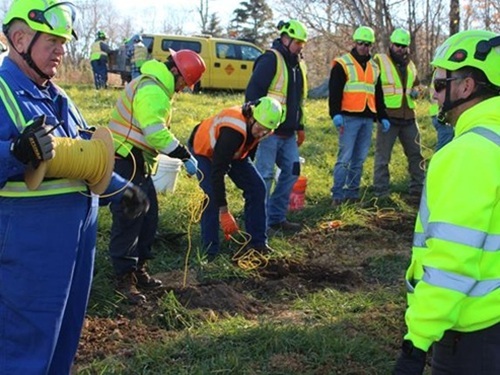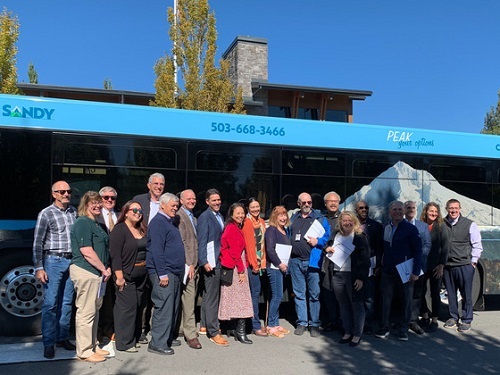State legislators in Oregon and Indiana recently wrapped up tours focused on, respectively, identifying future transportation funding needs and ways to improve highway work zone safety.
[Above photo by Oregon DOT]
The Oregon legislature conducted a 12-stop statewide “Transportation Safety and Sustainability Outreach Tour” from June through late September; traveling roads, bridges, bus routes, and pedestrian paths of Oregon’s coast, the Willamette Valley, southern Oregon, eastern Oregon, central Oregon and the Portland metropolitan area.
Each of those tour stops had three components: a day-time bus tour of the local transportation system, a roundtable discussion with local leaders, and a public hearing. At the public hearings, legislators talked with state residents about their transportation challenges, needs and priorities— as well as to examine the state of Oregon’s transportation system up close.
The Oregon Department of Transportation noted in a news release that the tour “bolstered legislative efforts” to address Oregon’s transportation budget challenges and develop a transportation funding package in the 2025 legislative session.

[Editor’s note: The Idaho Transportation Board recently passed a unanimous resolution authorizing a final $350 million bond sale in for the state’s Transportation Expansion & Congestion Mitigation or TECM highway program. It is anticipated that the TECM direct-pay and funds from bond sales will yield up to $1.6 billion in road construction projects over the life of the program, of which bond proceeds are just over $1.3 billion.]
“Safety and efficiency have been central parts of each stop along this tour and will be key to identifying an equitable transportation system that gets Oregonians and goods to where they need to go,” explained State Rep. Susan McLain, chair of the legislature’s Joint Committee on Transportation. “We’ve heard loud and clear from community leaders and from the public, both about their communities’ transportation needs, and, importantly, what funding solutions they would support to meet those needs.”
The Oregon DOT noted that it has enough funding to keep state highway maintenance levels roughly stable until the middle of 2025. After that, in the absence of additional revenue or revenue reform, state residents could see “a rapid decline” in the safety, quality, and reliability of their transportation system.
Meanwhile, a group of Indiana state legislators recently visited the current I-70 construction zone in Hancock County where the Indiana Department of Transportation operates a worksite speed control pilot program, known as Safe Zones, that helps keep both motorists and highway workers safe.

The five-year pilot program, authorized by House Enrolled Act 1015 during the 2023 legislative session, uses speed detection technology to monitor the speeds of passing vehicles.
“From the beginning, the purpose of my legislation establishing Safe Zones has been to gather information on how to keep our roads and those working on them safe,” said the bill’s author State Rep. Jim Pressel (R-Rolling Prairie) in statement. “Now, we have the opportunity to see for ourselves how this new law and the implementation of cameras in worksites impacts the overall safety of Hoosiers on roadways.”
Over the past decade, 269 people have been killed in crashes in highway worksites or in worksite backups in Indiana, noted INDOT. In 2023 alone, 33 people were killed and more than 1,750 were injured in INDOT work zones, the agency said, with four out of five people killed in work zones either drivers or their passengers.
Indiana Safe Zones aims to curb those numbers, INDOT Commissioner Mike Smith explains, noting that the Hancock County site along I-70 is the first deployment of the agency’s Safe Zone program. By statute, INDOT may deploy the technology in up to four sites at any given time – and the agency plans to announce additional locations as the program expands.
“We have to reduce speeds to make construction zones safer not only for road crews but also for motorists,” Smith said. “So far, many drivers are slowing down and we hope that continues. Lives depend on it.”
 States
States
NCDOT Staff Participate in ‘Explosive’ Technical Training
December 19, 2025 States
States

